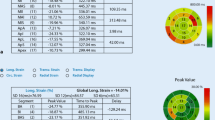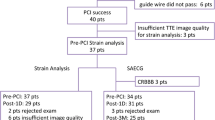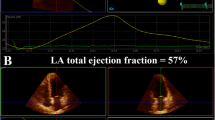Abstract
The changes of left ventricular ejection fraction (LVEF) were assessed after successful recanalization of chronic total occlusions (CTO) with or without previous myocardial infarction (MI) by real-time three-dimensional echocardiography (RT3DE). 32 patients with a successfully recanalyzed CTO were included in the present prospective study. The patients were divided into group 1 without previous MI and group 2 with previous MI in the territories of total occlusion vessel that was recanalized. In addition, there was a subgroup composed of 14 patients with collateral flow or retrograde flow in group 2. In all patients, LVEF was determined by RT3DE at baseline and after 6 weeks. In group 1, the evolution of LVEF increased significantly from 59.9 ± 7.2–67.5 ± 8.7% (P < 0.05). In group 2, the evolution of LVEF increased from 48.6 ± 6.1–50.1 ± 6.4%, however, it was without statistic significance (P > 0.05). The evolution of LVEF increased from 46.8 ± 7.1–53.0 ± 7.2% (P < 0.05) in the subgroup of group 2. Left ventricular function in patients with CTO can be feasibility and actually evaluated by RT3DE. The influence of recanalization of CTO on the improvement of left ventricular function was different between MI and non-MI patients. The left ventricular function did not improve in MI patients, but improved significantly in the patients having rich collateral circulation.

Similar content being viewed by others
References
Jenkins, C., Bricknell, K., Hanekom, L., et al. (2004). Reproducibility and accuracy of echocardiographic measurements of left ventricular parameters using real-time three-dimensional echocardiography. Journal of the American College of Cardiology, 44(4), 878–886.
Prakash, K., Li, X., Hejmadi, A., et al. (2004). Determination of asymmetric cavity volumes using real-time three-dimensional echocardiography: an in vitro balloon model study. Echocardiography, 21(3), 257–263.
Zeidan, Z., Erbel, R., Barkhausen, J., et al. (2003). Analysis of global systolic and diastolic left ventricular performance using volume-time curves by real-time three-dimensional echocardiography. Journal of the American Society of Echocardiography, 16(1), 29–37.
Bauer, F., Shiota, T., Qin, J. X., et al. (2001). Measurement of left atrial and ventricular volume in real-time 3D echocardiography: Validation by nuclear magnetic resonance. Archives des Maladies du Coeur et des Vaisseaux, 94(1), 31–35.
Qin, J. X., Jones, M., Shiota, T., et al. (2000). Validation of real-time three-dimensional echocardiography for quantifying left ventricular volumes in the presence of a left ventricular aneurysm: In vitro and in vivo studies. Journal of the American College of Cardiology, 36(3), 900–907.
Qin, J. X., Shiota, T., McCarthy, P. M., et al. (2000). Real-time three-dimensional echocardiographic study of left ventricular function after infarct exclusion surgery for ischemic cardiomyopathy. Circulation, 7(3), 101–106.
Ferrari, R., Ferrari, F., Benigno, M., et al. (1998). Hibernating myocardium: Its pathophysiology and clinical role. Molecular and Cellular Biochemistry, 186(1–2), 195–199.
Knap, J., Harrer, J., & Dominik, J. (1996). Hibernating myocardium-mechanisms and clinical implications. Acta Medica, 39(3), 95–99.
Rahimtoola, S. H. (1989). The hibernating myocardium. American Heart Journal, 117(1), 211–221.
Schwanke, U., Heusch, G., Schipke, J. D., et al. (2002). Mismatch of local blood flow and oxidative metabolism in stunned myocardium. Physiological Research, 51(1), 17–25.
Bax, J. J., Visser, F. C., Poldermans, D., et al. (2001). Relationship between preoperative viability and postoperative improvement in LVEF and heart failure symptoms. Journal of Nuclear Medicine, 42(1), 79–86.
Petronio, A. S., Baglini, R., Limbruno, U., et al. (1998). Coronary collateral circulation behaviour and myocardial viability in chronic total occlusion treated with coronary angioplasty. European Heart Journal, 19(11), 1681–1687.
Dervan, J. P., McKay, R. G., & Baim, D. S. (1987). Assessment of the relationship between distal occluded pressure and angiographically evident collateral flow during coronary angioplasty. American Heart Journal, 114(3), 491–497.
Sabia, P. J., Powers, E. R., Jayaweera, A. R., et al. (1992). Functional significance of collateral blood flow in patients with recent acute myocardial infarction. A study using myocardial contrast echocardiography. Circulation, 85(6), 2080–2089.
Fukai, M., Ii, M., Nakakoji, T., Kawakatsu, M., et al. (2000). Angiographically demonstrated coronary collaterals predict residual viable myocardium in patients with chronic myocardial infarction: A regional metabolic study. Journal of Cardiology, 35(2), 103–111.
Sabia, P. J., Powers, E. R., Ragosta, M., et al. (1992). An association between collateral blood flow and myocardial viability in patients with recent myocardial infarction. New England Journal of Medicine, 327(26), 1825–1831.
Werner, G. S., Ferrari, M., Heinke, S., et al. (2003). Angiographic assessment of collateral connections in comparison with invasively determined collateral function in chronic coronary occlusions. Circulation, 107(15), 1972–1977.
Werner, G. S., Ferrari, M., Betge, S., et al. (2001). Collateral function in chronic total coronary occlusions is related to regional myocardial function and duration of occlusion. Circulation, 104(23), 2784–2790.
Acknowledgment
This study was supported by a grant from Shandong Province Jinan Technological Development Program (2007-5-38).
Author information
Authors and Affiliations
Corresponding author
Rights and permissions
About this article
Cite this article
Yue, WW., Huangfu, FT., Yin, J. et al. Assessment of Recanalization of Chronic Total Occlusions on Left Ventricular Function in Patients With or Without Previous Myocardial Infarction by Real-time Three-Dimensional Echocardiography. Cell Biochem Biophys 62, 83–86 (2012). https://doi.org/10.1007/s12013-011-9262-9
Published:
Issue Date:
DOI: https://doi.org/10.1007/s12013-011-9262-9




